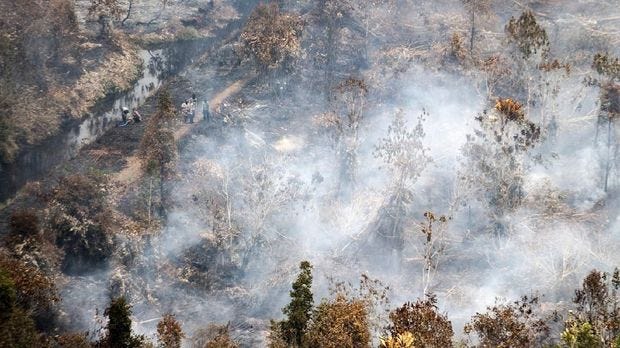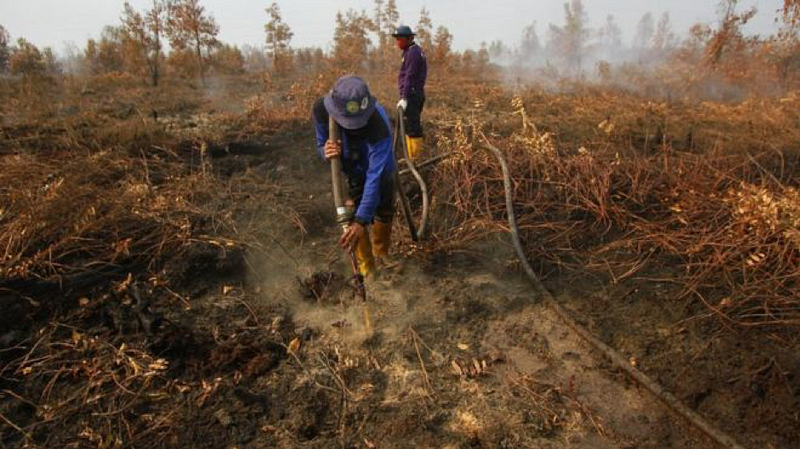Battling Through Massive Forest Fires in Kalimantan, Indonesia.
The fact that forest fires in Indonesia have not been extinguished and the smoke caused by these forest fires is increasingly dangerous also extends to many surrounding areas, 2019 is not an easy year for the Indonesian Environment.

Haze from forest fires caused several schools to be shut down, flights suspended, air quality worsened, and health problems warnings. Kalimantan is renowned for its peat deposits, where many forest fires occur. Once turned on, extinguishing will be difficult. CNN reported that Indonesian authorities arrested 185 people because they were considered responsible for activities related to forest and land fires (karhutla).
The thing that worries many Indonesians the most is that the rate of air cleanliness is getting worse in some places. In Indonesia, not a few areas are covered by thick smoke from forest fires.
Because the smoke has intensified and spread to many areas, the Malaysian government has issued an urgent letter to the local government to extinguish the forest fire immediately. Also, Malaysia has given an idea by sprinkling chemicals from the aircraft in the hope of creating artificial rain which would later extinguish the fire from the forest fire.

In the event of haze due to forest fires known as PM10, which is a term for light particles with a diameter of 10 micrometers or less that spreads in the air together with smoke haze. These particles are very small and invisible like gas, so when inhaled, these particles will enter and penetrate deep into the lungs so that it can cause interference with the respiratory system.
WHO statistics in 2018 said at least 543,000 children died in one year as a result of air pollution-related respiratory problems. Air pollution is considered one of the causes of childhood cancer. Additionally, pregnant women who are exposed to air pollution can affect the development of the fetal brain.
Besides that, the forest fire and its smoke also have a lot of side effects on the environment. According to insideclimatenews.org, it has been said that wildfires are releasing carbon dioxide and other greenhouse gases that will continue to warm the planet well into the future. It destroys forests while removing CO2 from the water. So it disperses in the air soot and other aerosols with complex effects on heating and cooling. Although it is difficult to calculate the exact amounts, scientists estimate that for the past 20 years, wildfires have released about 8 billion tons of CO2 per year. According to the International Energy Agency, total global CO2 emissions exceeded 32.5 billion tons in 2017.
Fires are not only burning trees and shrubs and smoking. They leave behind on the ground, long-lasting changes, and those changes even affect the climate.
Emissions from decomposing dead wood also surpass the direct emissions from the fire itself over several decades after a big fire. But at the same time, new growth is beginning to take CO2 from the atmosphere again and store it in burnt areas.
Moreover, fires affect the country’s reflectivity, called albedo. When burned forest areas start to regrow, light-colored patches of grasses and shrubs come in first, which can have a cooling effect until the vegetation thickens and darkens again because they reflect more solar radiation.

The fire that continues to expand in the middle of the dry season causes smog that reduces visibility, pollutes the air, disrupts flight traffic, and causes many health complaints. Because of that, efforts to extinguish the fire caused by the forest fire have been carried out by the government. Together, national and regional governments are making different efforts to eradicate fires and rising natural disasters. According to kompas.com, These are some ways that have been and are still being pursued by the Government to date are as follows:
1. Bring Down the Troops
Each of the provinces with many forest and land fires was mobilized by 1,512 personnel, namely Riau, Jambi, South Sumatra, West Kalimantan, Central Kalimantan, and South Kalimantan. There are 1,000 TNI members and 200 Indonesian National Police officers in each of these forces. Not only were leaders of BPBD and community involvement organized to speed up the blackout.
2. Water Bombing
32 helicopters were working to splash water on hotspots based on the National Disaster Management Agency (BNPB) report on September 14, 2019. Central Kalimantan, West Kalimantan, South Kalimantan, Riau, Jambi, and South Sumatra are among the operating regions.
3. Weather Modification
The government also worked on artificial rain or weather modification technology (TMC) through relevant agencies by using salt to seed clouds. 160,816 kilograms of salt was still used from the same study to seed clouds and rising rain.
4. Use of Calcium Oxide
Through the collaboration of BNPB, BMKG, and BPPT, the government later uses other smoke-reducing products, including the use of calcium oxide or active lime (CaO). Using Cassa 212 aircraft, CN 295, and Hercules C 130, this lime will be sown from the water. The solar radiation is expected to reach the earth’s surface after the smoke can be reduced and allow more clouds to form above the forest area.
Cloud seeding attempts will be made again after the smoke can be removed.

